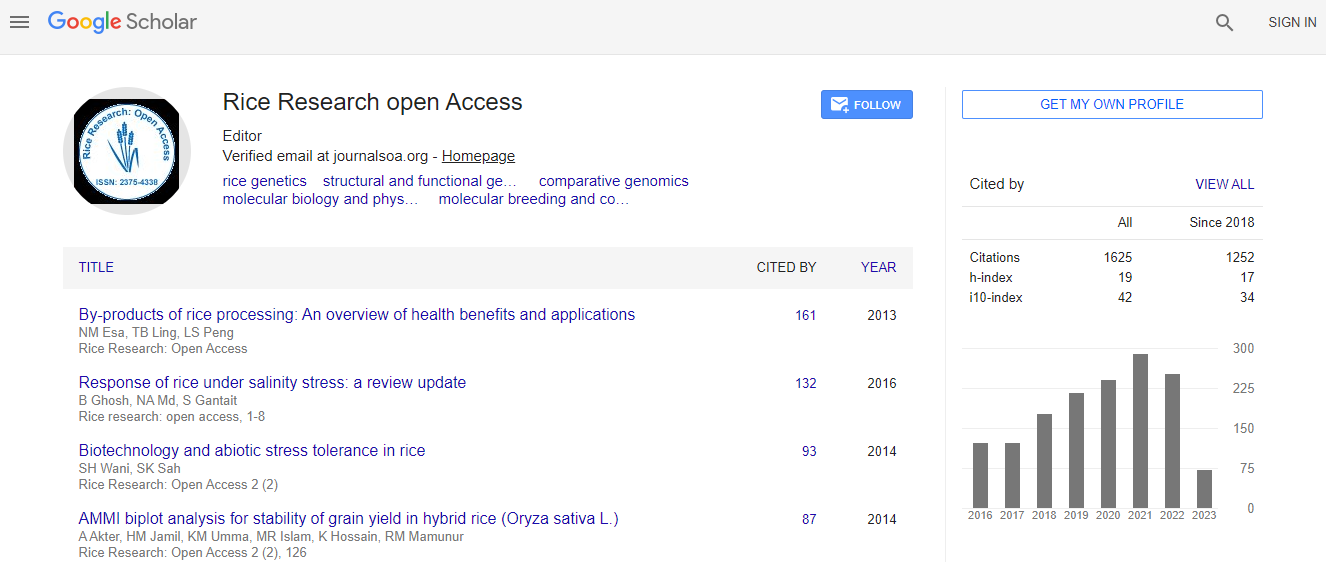Research Article
Genetic Diversity Studies on Selected Rice (Oryza sativa L.) Genotypes based on Gel Consistency and Alkali Digestion
Chemutai LR1*, Musyoki MA1, Kioko WF1, Mwenda NS1, Muriira KG2 and Piero NM11Department of Biochemistry and Biotechnology, Kenyatta University, Nairobi, Kenya
2Molecular Laboratory, Kenya Bureau of Standards, Kenya
- Corresponding Author:
- Lagat Rose Chemutai
Department of Biochemistry and Biotechnology, Kenyatta University, P.O. Box 43844-00100, Nairobi, Kenya
Tel: +254712848915
E-mail: roselagat76@gmail.com
Received Date: May 26, 2016; Accepted Date: August 01, 2016; Published Date: August 09, 2016
Citation: Chemutai LR, Musyoki MA, Kioko WF, Mwenda NS, Muriira KG, et al. (2016) Genetic Diversity Studies on Selected Rice (Oryza sativa L.) Genotypes based on Gel Consistency and Alkali Digestion. J Rice Res 4:172. doi: 10.4172/2375-4338.1000172
Copyright: © 2016 Chemutai LR, et al. This is an open-access article distributed under the terms of the Creative Commons Attribution License, which permits unrestricted use, distribution, and reproduction in any medium, provided the original author and source are credited.
Abstract
Knowledge of rice genetic diversity is necessary to ascertain the germplasm conservation and the development of improved rice genotypes with good quality traits through various breeding programs. The aim of this study was to determine the genetic diversity based on gel consistency and alkali digestion among selected Kenyan and Tanzanian genotypes using SSR markers. PowerMarker version 3.25, GenAlEx version 6.41 and DARwin 6.0.12 statistical software were used to carry out data analysis. The number of alleles per locus ranged from 2 to 4 with an average of 2.75 across the 8 markers used. Polymorphic information content (PIC) ranged from 0.5224 (RM577) to 0.1411 (RM85) with an average of 0.3673 observed across all the markers. Gene diversity ranged from 0.5764 (RM577) to 0.1528 (RM85) with an average of 0.4181 with one rare allele was detected at RM577 loci. Pairwise genetic dissimilarity matrix ranged from ranged from 0.9333 to 0.1818 with the least genetic distance being observed between IR 54 and BS 370 while the highest, 0.9333 being between Saro 5 and IR 2793. The unweighted neighbour joining tree clustered the rice genotypes into three major clusters and subsequent sub clusters hence effectively differentiating the Kenyan and Tanzanian genotypes based on gel consistency and alkali digestion. This clustering was complemented with the findings in the principal coordinate analysis. These results show that determination of genetic diversity using SSR markers cam be successfully achieved. In this study RM577 was the best and most informative SSR marker given it showed the highest PIC, gene diversity and allele per locus. In addition, it’s the only marker that showed a rare allele at 400 bp.

 Spanish
Spanish  Chinese
Chinese  Russian
Russian  German
German  French
French  Japanese
Japanese  Portuguese
Portuguese  Hindi
Hindi 
